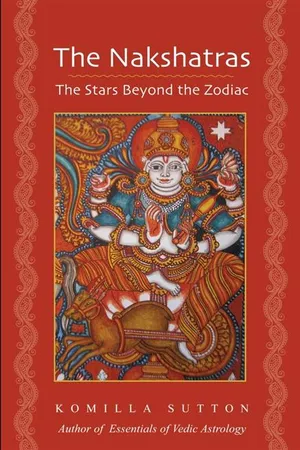
- 340 pages
- English
- ePUB (mobile friendly)
- Available on iOS & Android
eBook - ePub
About this book
Komilla Sutton is a co-founder of the British Association for Vedic Astrology. She is renowned as both a practitioner and teacher of the science with students and clients all over the world. Readers of her previous books (The Essentials of Vedic Astrology, The Lunar Nodes and Personal Panchanga) have long been asking for a book on the nakshatras, the lunar mansions - so here it is.
Frequently asked questions
Yes, you can cancel anytime from the Subscription tab in your account settings on the Perlego website. Your subscription will stay active until the end of your current billing period. Learn how to cancel your subscription.
At the moment all of our mobile-responsive ePub books are available to download via the app. Most of our PDFs are also available to download and we're working on making the final remaining ones downloadable now. Learn more here.
Perlego offers two plans: Essential and Complete
- Essential is ideal for learners and professionals who enjoy exploring a wide range of subjects. Access the Essential Library with 800,000+ trusted titles and best-sellers across business, personal growth, and the humanities. Includes unlimited reading time and Standard Read Aloud voice.
- Complete: Perfect for advanced learners and researchers needing full, unrestricted access. Unlock 1.4M+ books across hundreds of subjects, including academic and specialized titles. The Complete Plan also includes advanced features like Premium Read Aloud and Research Assistant.
We are an online textbook subscription service, where you can get access to an entire online library for less than the price of a single book per month. With over 1 million books across 1000+ topics, we’ve got you covered! Learn more here.
Look out for the read-aloud symbol on your next book to see if you can listen to it. The read-aloud tool reads text aloud for you, highlighting the text as it is being read. You can pause it, speed it up and slow it down. Learn more here.
Yes! You can use the Perlego app on both iOS or Android devices to read anytime, anywhere — even offline. Perfect for commutes or when you’re on the go.
Please note we cannot support devices running on iOS 13 and Android 7 or earlier. Learn more about using the app.
Please note we cannot support devices running on iOS 13 and Android 7 or earlier. Learn more about using the app.
Yes, you can access Nakshatras by in PDF and/or ePUB format. We have over one million books available in our catalogue for you to explore.
Information
Publisher
The Wessex AstrologerYear
2014Print ISBN
9781902405926eBook ISBN
97819024059711
An Introduction to the Nakshatras
‘Nakshatra’ is the original language of the stars with which the ancient sages connected to intangible spirit. They tried to decipher the meaning of life from qualities beyond the zodiac, where the gods and goddesses lived in a world that is free from pain and sorrow. The Sages felt that if they could understand the language of the stars and work with their cosmic patterns they could truly learn to override the daily turbulence of the human life and mind. The word ‘nakshatra’ literally means a star. Each nakshatra is a group of several thousand fixed stars comprising 13° 20′ of the ecliptic – the number of degrees travelled by the Moon in a 24-hour day. One rashi or sign has 2¼ nakshatras within it. Breaking it down further, Naksha means ‘to get closer’ and Tra means ‘to preserve’. ‘Nakshatra’ also therefore means ‘one that never decays’. The nakshatras’ cosmic remit is to be the guardians of the soul during its journey through many human lifetimes, and bring divine knowledge to earth.
The nakshatras represent the mind: the higher and lower energies and daily struggles for peace and calmness amid the uncertainties and pressures. They show the mind’s ability to be part of the higher self, the evolution of consciousness, and to be at one with the divine. They also indicate the emotional chaos, unhappiness and sorrows which the mind copes with on a daily basis. The nakshatras deal with karma which is stored in the mind, whose daily fluctuations keep us from developing towards self-realization.
The nakshatras relate to two key aspects – the eternal and the ever changing. They represent the fixed stars which are constant, and the Moon/mind which is always changing. This interaction, if truly understood, can bring deeper knowledge of consciousness, karma and the search for happiness.
Although the Moon’s position in a nakshatra is of prime importance, the quality of the other planets is also influenced and altered by their nakshatra position. To study the deeper meanings of life, the nakshatra placements of all planets must be analysed and this will give a better understanding of the inner motivations of the planets in your chart.
Gayatri Mantra and the Nakshatra Loka
The Gayatri mantra, which is the greatest chant in the Vedas, connects to the inner meaning of the world (loka) of nakshatras. This chant is about the three worlds and prays to the solar god Savitur to show us the inner light beyond the visible light of the Sun.
The Gayatri Mantra

Om bhûr bhuvah svah tat savitur varenyam
Bhargo devasya dhîmahi dhiyo yo nah pracodayât
Bhargo devasya dhîmahi dhiyo yo nah pracodayât
I pray to God Savitur, who appears through the Sun to show the light that has given birth to all the three Worlds. Please illuminate our intellect and show us the inner light.
This chant tells us of the three worlds which are:
Bhur – Earth
Bhuvah – Sky
Svah – Swarga or heaven
This mantra also teaches us about the Earth, Sun and Moon:
Bhur – the Earth is where the humans live, and Mercury or the intellect is its lord.
Bhuvah – the sky is the path of the Sun and the zodiac.
Svah – heaven, where the nakshatras shine their light and the devas (gods and goddesses) live. Heaven is under the jurisdiction of the Moon.
The Gayatri mantra helps us to understand the concept of Atma, Buddhi, Manas – Soul, Intellect and Mind. Atma is the Sun, Buddhi is Mercury and Manas is Moon. Atma lives in the world of the Sun, Intellect in the Earth and the Mind is beyond these two. Of these, the mind is the most difficult to control. It can block us, make us unhappy and bring instability. Hence chanting the Gayatri Mantra helps in calming the mind and developing its higher nature.
The Myth of the Nakshatras: The Wives of Soma
The nakshatras are the twenty-eight daughters1 of Daksha Prajapati who became the wives of Soma, the Moon god. Daksha Prajapati allowed Soma to marry his daughters on the condition that he, Soma would treat them equally. Soma visited one wife per day. Soon he started showing preference to Rohini and was spending a little extra time with her, which made the other wives jealous. They complained to Daksha Prajapati and he cursed Soma who started dying. The wives realized their mistake and begged their father to remove the curse. Daksha Prajapati explained that a curse once given cannot be taken back but he modified it so that Soma would die and be reborn every month. This became the waxing and waning cycle of the Moon. When the Moon transits the nakshatras, visiting the symbolic wives of Soma, it activates the differing aspects of the human mind, their soul desires and their changing moods.
Nakshatras – The Lunar Mandala
In the beginning there were no equal divisions of the sky. The nakshatras were of varying lengths and their guiding stars were given great importance. In Vedanga Jyotish2, Dr Mishra refers to this and further adds that over time the nakshatras were divided into 28 sections. Then the sages modified the nakshatras and made them equal in size. They decided to make one nakshatra equal to the distance the Moon travels in one day which is 13°20′. They were able to divide the sky into 27 sections and the 28th nakshatra is shorter and is intercalary (outside the nakshatra belt). The nakshatras were usually referred to by the names of their deities and not the nakshatra name. This practice is still prevalent especially in Muhurta and Prashna.
The nakshatras are divided into three cycles of nine, which are always ruled by the planets in the same order. The nine planets are Ketu, Venus, Sun, Moon, Mars, Rahu, Jupiter, Saturn and Mercury. The division of the sky into 27 sections relates to the Moon as it stays in one nakshatra for a day.
The 28th Nakshatra
There is also a nakshatra called Abhijit that was part of the original nakshatra mandala. Abhijit is 4°13′20″ long and is placed between 6°40′ and 10°53′20″ Capricorn and it was the most auspicious nakshatra during the ancient times. It was such a powerful nakshatra that if an important activity began when the Moon was in Abhijit nakshatra, it guaranteed unparalleled success.
During the Mahabharata3, Lord Krishna came to know that Duryodhana was planning to start a war with five Pandava brothers at a time when the Moon was in Abhijit. He was aware of the power of the Abhijit. The Kauravas were planning to begin Mahabharata when it was Amavasya tithi (New Moon) and the Moon was in Abhijit nakshatra; this day would be an extremely potent one to bring a successful outcome. This combination can only happen when the Sun is in Capricorn and is an unbeatable combination for victory over an enemy. Lord Krishna knew that if the Kaurava and Duryodhana started Mahabharata on this day, the Pandava would lose, so he removed Abhijit nakshatra from the nakshatra mandala; he wanted to avoid misuse of this auspicious nakshatra.
This nakshatra was placed beyond the nakshatra belt and so became an intercalary nakshatra. It remains 6°40′ to 10° along the side of Uttara Ashadha and 10° to 10° 53′20″ by Shravana.
27 or 28 Nakshatras
There are different schemes of nakshatras; one that uses Abhijit and others that don’t. Abhijit is not used in natal astrology, but it is important for Panchanga and many other aspects and in Kali Yuga we only use twenty seven nakshatras. But old traditions remain and some techniques still use twenty eight nakshatras.
The 28 Nakshatras
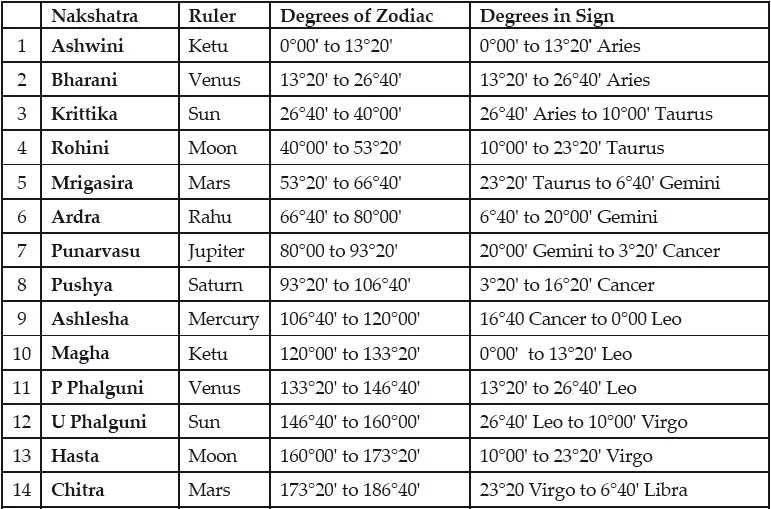
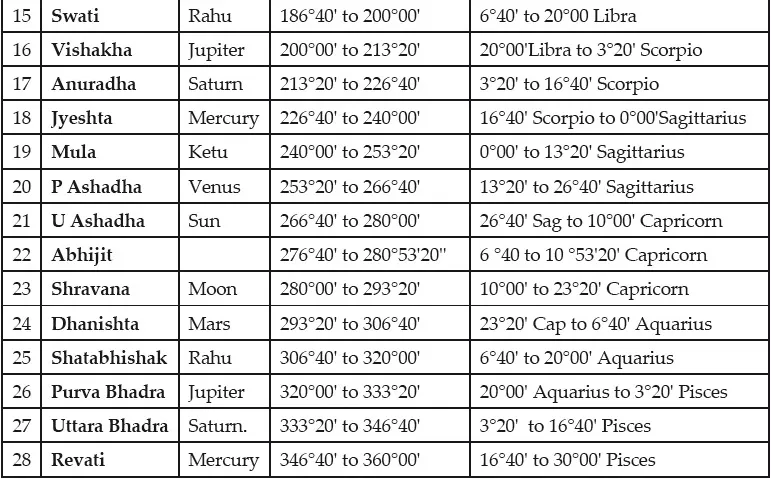
Abhijit should be seen as another secret link to help us understand the true quality of the soul; a bridge that leads us to deeper, more spiritual concepts – and therefore its knowledge is essential for the more serious astrologer. When we are studying Abhijit, we should think of it existing side by side with Uttara Ashadha and Shravana nakshatras, and all analysis should include both.
Nakshatra and Their Padas
Pada means foot or steps. There are four steps in each nakshatra. As the Moon remains in one nakshatra for one day, the padas reflect the natural divisions of the day: sunrise, midday, sunset and midnight.
Only 27 nakshatras are used for the padas. Each pada is the same as the navamsha and equals 3°20′ each. The terms pada and navamsha are often interchangeable. In this book I will mostly use pada.
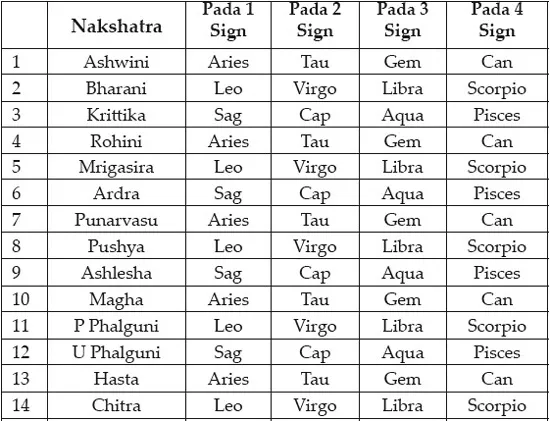
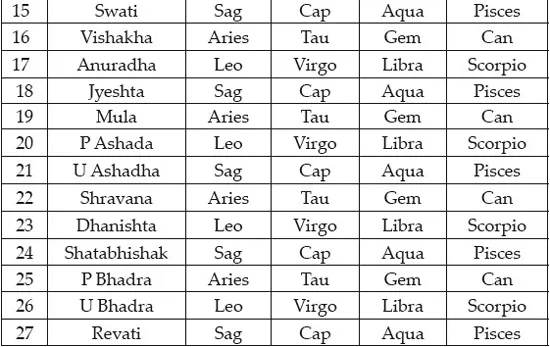
Further Padas Classifications
The nakshatras relate to each other through the sequence of rulership of the padas – nine nakshatras will have the same padas. This is an important connection and it is used in techniques for understanding the nakshatras.
Aries to Cancer padas are within Ashwini, Rohini, Punarvasu, Magha, Hasta, Vishakha, Mula, Shravana and Purva Bhadra. They are ruled by Ketu, Moon and Jupiter. These nakshatras show the various beginning cycles of new levels of the soul’s development. They are searching for and creating fresh energies depending on the level of their manifestation.
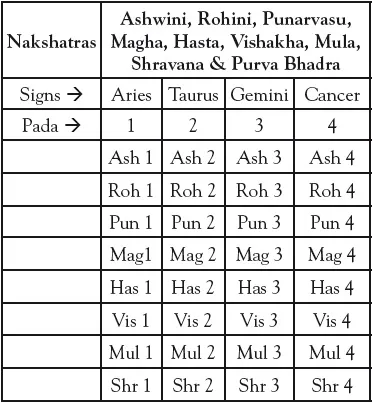
Leo to Scorpio padas are within Bharani, Mrigasira, Pushya, Purva Phalguni, Chitra, Anuradha, Purva Ashadha, Dhanishta and Uttara Bhadra. Venus, Mars and Saturn nakshatras show the soul’s involvement in settling down into a certain way of being and then learning it is not good enough; so sparking the need for change.
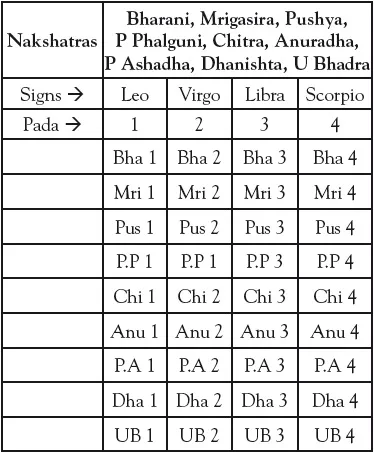
Sagittarius to Pisces padas are within Krittika, Ardra, Ashlesha, Uttara Ashadha, Swati, Jyeshta, Uttara Ashadha, Shatabhishak, Revati. Sun, Rahu and Mercury rule them and they are seeking self-realisation. They are the ending cycles of the soul’s development. These nakshatras end one way of thinking and aspire to move to the next level.

How Rashi and the Nakshatras Connect
The rashi division (twelve signs from Aries to Pisces) is the solar zodiac, and planets in the rashi show how we deal with Atma, the universal soul.
The nakshatras (Ashwini to Revati) form the lunar mandala and reflect the Jiva Atma, the living soul. The mandala shows how the mind works either with the soul or against it. It can indicate both intuition and blocks.
The rashi and nakshatras are connected by the navamsha and pada; the navamsha is the 9th division of the solar zodiac and the padas are the 4th division of the lunar one. Nava means nine and amsha means division. Navamsha means nine divisions. Each rashi is divided by nine navamsha that equals 3°20′. One nakshatra is 13°20′ and if you divide one nakshatra by four there are four 3°20 pada. So the navamsha division and the nakshatra pada are one and the same division. The nakshatra padas and the navamsha both divide the zodiac into 108 parts.
| Rashi, Nakshatra, Navamsha Mathematics Solar Rasi: 9 navamsha in 12 signs = 108 divisions Lunar nakshatras: 27 naksha... |
Table of contents
- Cover Page
- Title Page
- Copyright Page
- Acknowledgements
- Dedication
- Contents
- Glossary
- 1 An Introduction to the Nakshatras
- 2 Nakshatra Characteristics
- 3 Strength and Weakness in the Nakshatras
- 4 The Nakshatras
- 5 Nama Nakshatra: The Technique of Choosing the Right Name
- 6 The Gunas or Qualities of the Mind
- 7 Nakshatra Gandanta: The Spiritual Knot
- 8 The Sexuality of the Nakshatras: Yoni and Animal
- 9 Nadi Nakshatra: The Secret Pulse
- 10 Analysis: Revealing the Mind
- Footnotes